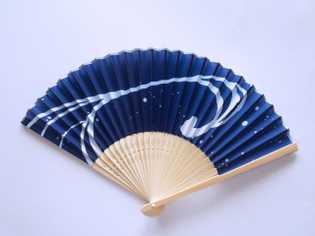扇子(せんす) - Sensu (a folding fan)
A sensu is used as an accessory for kimonos. The sensu originated from a round fan called an uchiwa, which was introduced from China over a thousand years ago. The sensu was created by the Japanese who improved the uchiwa. The sensu has ribs covered with Japanese paper. The ribs are generally made of bamboo, but they are also sometimes made of sandalwood, which is a quality aromatic wood. When opened the sensu becomes fan-shaped and when it is closed it is a compact bar. In addition to that this light fan can be carried anywhere, it is also an indispensable prop used for Japanese dancing and for comic storytelling which is called rakugo. A folding fan is also called a suehiro, which means that it widens towards the end and therefore symbolizes good fortune. Folding fans generally have pictures of pine trees, bamboo, Japanese plum (ume) trees, cranes, and tortoises drawn with colors such as gold, silver, red, and white to symbolize good fortune. A folding fan, for this reason, is indispensable and is used on various auspicious occasions. Folding fans are used as props and accessories and are also presented as commemorative gifts. Moreover, folding fans are often drawn as a motif of a decoration such as a painting for auspicious occasions.
扇子は携帯用の扇で、和服のアクセサリーの一つとして使用されています。千年以上前に中国から伝えられた団扇(うちわ)を原形とし、日本人によって折り畳み式に改良されました。竹または香木の一つで高級品とされる白檀の骨に和紙を張って作ってあり、広げると扇形になり、閉じると1本の棒になります。扇子は携帯用の扇としてだけでなく、日本舞踊や落語に欠かせない小道具としても使用されています。扇子は広げると末広がりの形になるため、幸運の象徴とされています。このため、扇子には金銀や紅白などの色を使って松・竹・梅・鶴・亀などの絵がよく描かれます。扇子は祝い事に欠かすことのできないものとして色々な場面に使用されており、小道具として使用されたり、記念品として贈られたりすることがよくあります。また、祝い事に使用する絵画などの装飾品のモチーフとして扇子の絵が描かれることも珍しくありません。
